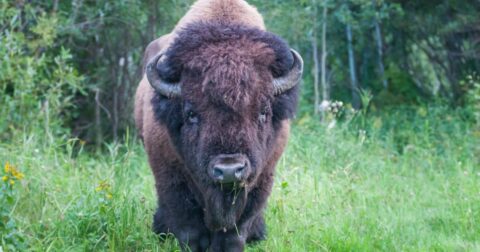News
Bird Flu Virus Might Resist Fever, Study in Mice Finds
Research•5 min read
Perspective
Tens of millions of bison once roamed North America until ranchers decimated their numbers. But today, Indigenous-led projects are restoring the bison and their ecosystems.


Words by Shawna Gray
Tens of millions of bison once roamed North America. These creatures played a critical role in maintaining the balance of this vital ecosystem, yet farmers saw them as little more than a species in the way of their plans to operate massive cattle farms. Together with the government, ranchers followed a violent policy of decimating bison populations — both to push Indigenous peoples onto reserves and free up land for cattle farming. Ultimately this government tactic, combined with overhunting, resulted in the slaughter of upwards of 50 million bison, leaving fewer than 1000 left in the wild by the 1880s. But today, Indigenous-led projects are restoring the bison and their ecosystems.
The bison and Indigenous peoples are brethren — culturally, materially and spiritually interrelated. In his memoir, Recollections of an Assiniboine Chief, Ochankuga’he (Daniel Kennedy) described how “the destruction of the buffalo was a mortal blow.” He recalled witnessing “acres and acres of dead buffalo packed closely together, rotting in the sun.”
This wide scale slaughter created crippling hardship and a profound spiritual wound on Indigenous peoples, transforming their world and the sacred relationships with the Earth and her inhabitants. Forced onto reserves and into reliance on food and sundries doled out by colonizers, Indigenous peoples were legally restricted from cultural practices and ongoing participation in reciprocal relationships with this Earth, our mother.
Western farming practices were introduced as a way to control and assimilate Indigenous peoples. For example, the Government Farmer’s role was to introduce the western concepts of sedentary, self-sufficient subsistence farming of crops, orchards and livestock through instruction and land allotment. On reserve government agents provided farming instruction and forcibly took children to residential schools, taking Indigenous peoples further from our knowledge of, and deep connection to, this land. The colonial way of interacting with the Earth caused further devastation through practices that were exploitative, extractive and lacking in diversity. The shift away from Indigenous farming disrupted Native plants, animals, waters and entire ecosystems.
Where Indigenous ways of knowing emphasize reciprocity, sustainability and interconnectedness, the colonial perspective emphasized dominance, ownership and control over the ecosystem. As part of a systemic government policy of eradicating Indigenous culture and the colonial disdain for Indigenous ways of knowing, colonizers suppressed and invalidated Indigenous science and knowledge in mainstream society.
Despite the horrific impacts of colonization, Indigenous peoples have preserved knowledge and maintained deep connections to the land. Indigenous peoples recognized they had a responsibility and role in restoring populations of their relative, the bison.
As such, in 2014, the first signatories of the Buffalo Treaty gathered at the Blackfeet Reservation in Montana. This treaty represents a commitment to create safe space for bison to conserve and nurture the land. Many organizations are working toward the restoration of bison as a free ranging, wild species, securing spaces to allow for migration.
Less than 10 percent of the 500,000 bison in North America today live in wild herds, scattered in national parks, conservation areas and on Indigenous lands. One group, American Prairie, has the goal of working collaboratively to secure 3.2 million acres of land in Montana (anchored by the Charles M. Russell National Wildlife Refuge). A land base of this size can sustain tens of thousands of bison. American Prairie is currently working toward building a wild herd of 5,000 bison. There are opponents to this plan, such as cattle ranchers who fear their land might be breached by roaming bison (who they wrongfully assert might also spread the disease brucellosis) and crop farmers who worry bison will disrupt their operations.
Ranching interests put forward other solutions to restore damaged ecosystems. One industry response has been to promote regenerative agriculture and grazing practices to reduce greenhouse gasses. But numerous studies have shown this approach is ineffective and it continues to demonstrate an exploitative view toward the natural environment.
Indigenous-led projects to restore and rewild bison and other keystone species are holistic, taking the entire natural ecosystem into account. These projects aim to restore systems of interaction that have been in existence since time immemorial, using information passed down by traditional knowledge keepers who gained carefully preserved knowledge from their Elders and through cultural revitalization.
As a keystone species, bison contribute to their ecosystem on multiple levels. Large bison wallows establish gardens as these creatures plant seeds that fall from their coats. The resulting plants and deep-rooted grasses lock carbon in the soil. Wallows also collect water seasonally, creating a habitat for frog and salamander breeding. As they walk the plains, bison aerate the soil, and ecologists have observed that certain plants grow only in their hoofprints. Their grazing activity and their droppings create an environment where diversity flourishes. Bison lengthen springtime green up through their interactions with the land, an effect so profound it can be observed from space. Birds, such as burrowing owls and plovers, gather the hair of their shedded winter coats to build nests.
In the bison’s wake, smaller species flourish and carnivores benefit from greater abundance of animal life, including bison, for prey. Unlike cattle, bison are adapted to a wide range of environmental conditions. Able to withstand wind, sun and cold, they graze in a larger area than cattle, which causes less damage to delicate plants and waterways. Within months of being returned to an area in Saskatchewan at Waneskewin Heritage Park, the bison revealed a bison rib stone petroglyph near a historical wallow cite, fulfilling an Indigenous prophecy that their return would mark a time of positive change.
The destiny of bison and Indigenous peoples has always been intertwined and connected to the sacred Earth. Decolonization includes restoration of these natural relationships. Bison know these lands; their Ancestors guide them to walk a path of healing this Earth.
Sentient Media’s Indigenous Voices for Saving Animals and Earth is a collection of essays illuminating important perspectives from Indigenous peoples, including traditional knowledge from the past and proposed solutions for the future. Edited by Jessica Scott-Reid, this project tackles land and water sovereignty, factory farming, food systems, veganism, colonialism, reconciliation and more, through a variety of Indigenous lenses.